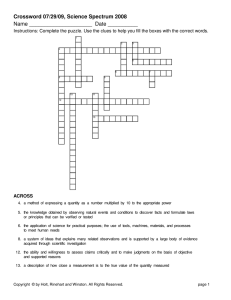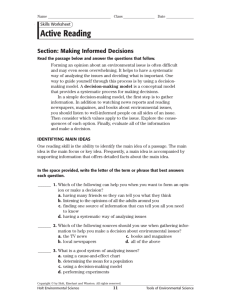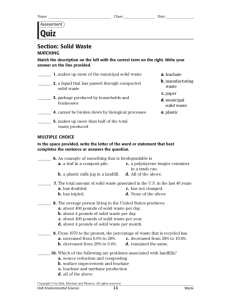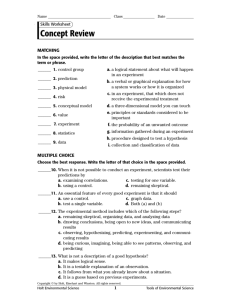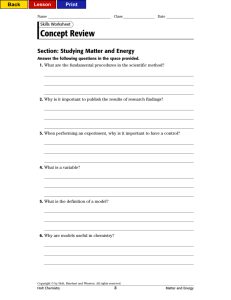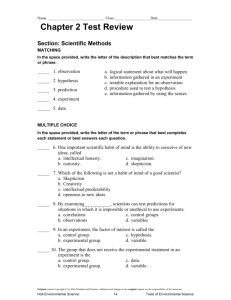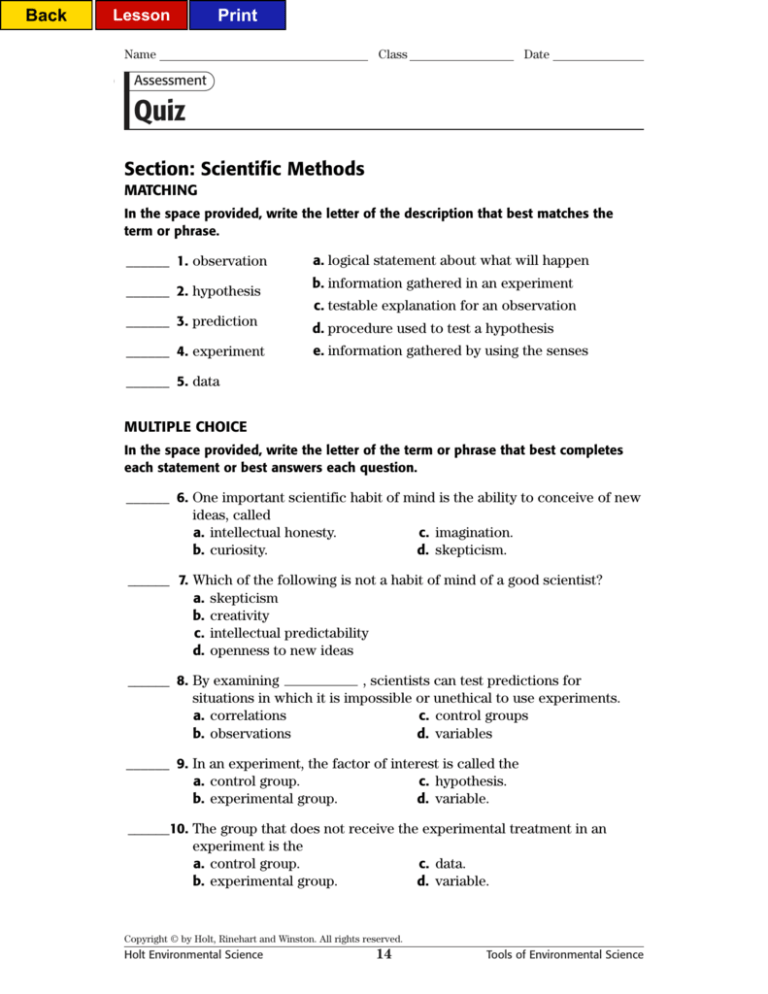
Back
Lesson
Print
Name
Class
Date
Assessment
Quiz
Section: Scientific Methods
MATCHING
In the space provided, write the letter of the description that best matches the
term or phrase.
______ 1. observation
______ 2. hypothesis
a. logical statement about what will happen
b. information gathered in an experiment
c. testable explanation for an observation
______ 3. prediction
______ 4. experiment
d. procedure used to test a hypothesis
e. information gathered by using the senses
______ 5. data
MULTIPLE CHOICE
In the space provided, write the letter of the term or phrase that best completes
each statement or best answers each question.
______ 6. One important scientific habit of mind is the ability to conceive of new
ideas, called
a. intellectual honesty.
c. imagination.
b. curiosity.
d. skepticism.
______ 7. Which of the following is not a habit of mind of a good scientist?
a. skepticism
b. creativity
c. intellectual predictability
d. openness to new ideas
______ 8. By examining
, scientists can test predictions for
situations in which it is impossible or unethical to use experiments.
a. correlations
c. control groups
b. observations
d. variables
______ 9. In an experiment, the factor of interest is called the
a. control group.
c. hypothesis.
b. experimental group.
d. variable.
______10. The group that does not receive the experimental treatment in an
experiment is the
a. control group.
c. data.
b. experimental group.
d. variable.
Copyright © by Holt, Rinehart and Winston. All rights reserved.
Holt Environmental Science
14
Tools of Environmental Science
Back
Lesson
Print
TEACHER RESOURCE PAGE
Active Reading
8.
9.
10.
11.
12.
SECTION: SCIENTIFIC METHODS
1. A single variable is tested; a control
is used.
2. They study two groups or situations at
a time.
3
2
5
1
Answers may vary but should include
a reference to making informed
decisions.
3. to pinpoint cause and effect
relationships
Map Skills
4. control group
5. experimental group
6. everything except the variable being
1. maple-beech-birch; oak-hickory
2. Answers may vary but students should
studied
notice a general northward migration
of tree species.
3. Answers may vary but students
should conclude that if the maple
tree population declines, this could
destroy the maple syrup industry in
New England.
4. Answers may vary but students
should suggest further modeling and
making first-hand observations of
actual temperature change and
species migration over time.
7. the level of phosphate in the water
8. a
9. Using both helps determine whether
or not a hypothesis is correct.
10. Phosphate in the water is killing the
mussels.
SECTION: STATISTICS AND MODELS
1. Individuals in a population have differ2.
3.
4.
5.
6.
7.
8.
9.
10.
11.
12.
ent characteristics.
by determining a mean
by adding up the data for a given characteristic and dividing this sum by the
number of individuals for which data
was collected
d
c
a
4
5
2
1
3
Answers may vary. Sample answer:
Scientists can easily compare different
populations by comparing their means.
Quiz
SECTION: SCIENTIFIC METHODS
Matching
1. e
2. c
3. a
4. d
5. b
Multiple Choice
6. c
7. c
8. a
9. d
10. a
SECTION: STATISTICS AND MODELS
Matching
1. c
2. b
3. a
4. a
SECTION: MAKING INFORMED
DECISIONS
1.
2.
3.
4.
5.
d
d
c
c
to act on principles or standards we
consider important
6. a conceptual model that provides a
systematic process for making
decisions
7. 4
Multiple Choice
5. b
6. b
7. d
8. d
9. c
10. a
SECTION: MAKING INFORMED
DECISIONS
Matching
1. d
2. e
3. a
4. b
5. c
Multiple Choice
6. c
7. a
8. d
9. b
10. b
Copyright © by Holt, Rinehart and Winston. All rights reserved.
Holt Environmental Science
94
Tools of Environmental Science

